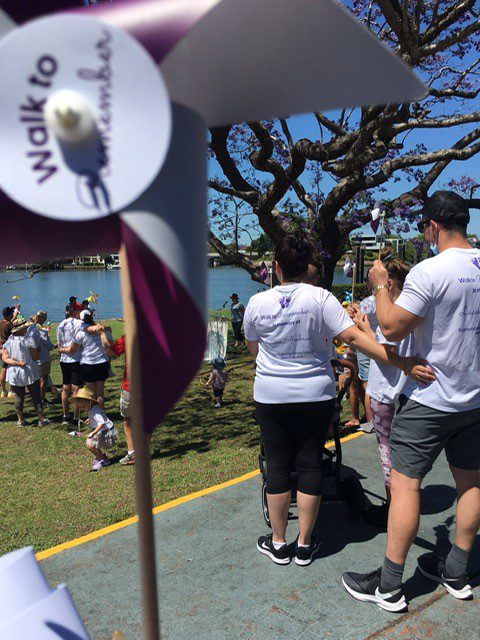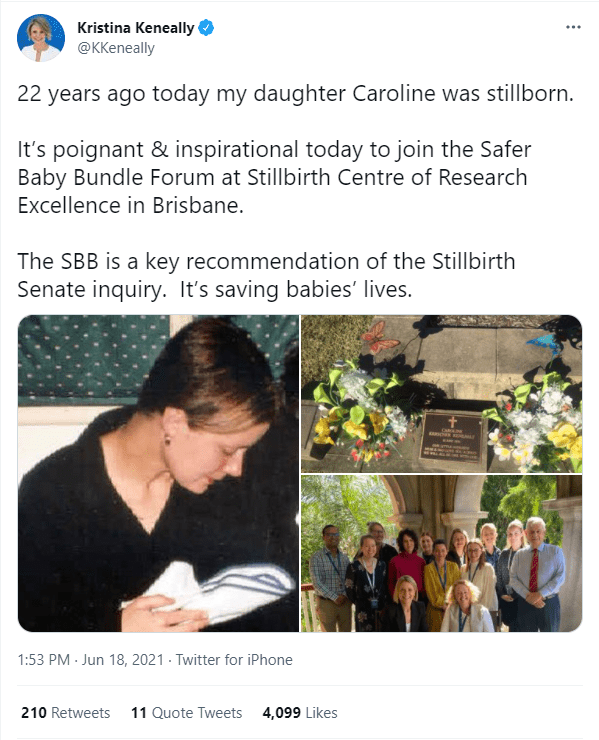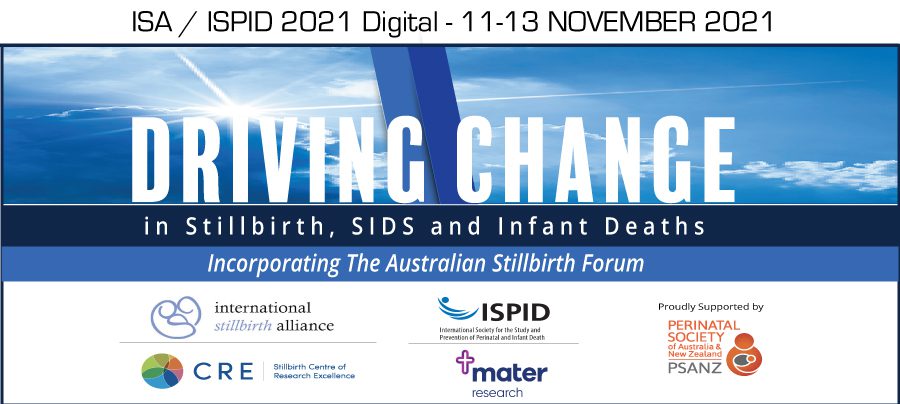
In February this year, the Federal Parliament of Australia officially recognised October 15 as Pregnancy and Infant Loss Remembrance Day – an important acknowledgement for the women and families who have lost a baby through stillbirth, infant death or miscarriage.
Some of our close partners are acknowledging this month and day by organizing ceremonies and events to mark the dates.

The Wave of Light on October 15 at 7pm was an opportunity for everyone to support bereaved families. Sands, Mater Mothers, Red Nose and other organisations held candle-lighting remembrance ceremonies and other community events for people to join.
Associate Professor Fran Boyle walked with other families and supporters in the 2021 Sands Red Nose Walk to Remember in Brisbane, photo left.
The University of Queensland lit up the iconic Forgan Smith Building at the St Lucia Campus in recognition of the importance of the date. Watch Professor Vicki Flenady's video here.
Click on the links above to find out more.
The Stillbirth CRE is hoping that this month and day can help bring about greater public awareness and reinforce our mission to help reduce the devastating impact of stillbirth on women, families and communities across Australia and the world.

October is Pregnancy and Infant Loss Awareness Month and we recognise and send our condolences to all parents who have experienced the tragedy of stillbirth or newborn loss.
The Stillbirth CRE is currently coordinating a research study to evaluate a new online support program for parents called ‘Living with Loss’. The Living with Loss program covers a broad range of topics and includes evidence-based strategies to help navigate grief in the short and longer-term. This new online program was co-designed by bereaved parents and healthcare professionals and aims to provide another option of support for parents.
The Living with Loss research team invites parents who have experienced stillbirth or the death of their newborn baby in the past two years to participate in this research study. We are also looking for health care providers to join us and share this research study with parents who have experienced stillbirth or newborn loss.
To find out more, or to register for the program, please visit Living with Loss.
On 17-18 of June the Stillbirth CRE held the first ever National Safer Baby Bundle (SBB) Forum. The purpose of the forum was to share our knowledge and experiences from the rollout of the Safer Baby Bundle initiative across the nation.
This virtual forum, held on two half days, included presentations from 32 speakers, panel discussions with seven of the SBB jurisdictional leads, and SBB element workshops which highlighting the latest best practice recommendations and common implementation challenges across jurisdictions.
The forum was a free online event bringing together health professionals, parents, researchers, policy makers, and advocates for stillbirth prevention. All eight jurisdictions were well represented with 362 participants joining on Day 1 and 269 joining on Day 2, showing the interest and growing awareness of the SBB nationally.
Senator Kristina Keneally closed the session by reflecting on the importance of this day to her and sharing that the day marked the anniversary of her daughter Caroline’s death, stillborn 22 years ago. Senator Keneally thanked all involved for their work across this important initiative and encouraged everyone to continue working together to reduce stillbirth.
To access the full recording of the 2021 National Safer Baby Bundle Virtual Forum click here.

Senator Kristina Keneally's tweet from June 18 this year
The Stillbirth Centre of Research Excellence is excited to announce that it has secured funding from the NHMRC for the next five years.
The Centre will continue its mission to reduce Australia’s stillbirth rates by 20 per cent and reconcile inequities in stillbirth rates by 2025. Professor Vicki Flenady received a $3.37 million Investigator Grant in addition to $2.5 million for the Stillbirth CRE.
This funding will enable the CRE to continue to focus on reducing the devastating impact of stillbirth on women, families and communities across Australia and the world.
In addition, the CRE has received new funding from the Australian Department of Health which will enable cultural adaptation and implementation of Safer Baby Bundle resources in maternity services in Aboriginal and Torres Strait Islander communities.
Read the Mater News story here.
All NHMRC funding outcomes are here.

The 2021 ISA-ISPID conference is all digital this year, and no matter where you are in the world be sure to register for this year’s meeting if you haven’t already. It will be held via a high-tech internet platform from 11-13 November.
This year will be the first time that the CRE-led National Forum has been incorporated into the conference.
Those at work behind the scenes have created a truly fascinating and thoughtful program, which promises to address global issues of stillbirth, neonatal death, SIDS and SUDI.
The event is a unique coming-together of parents, policymakers, clinicians and researchers to exchange knowledge and review progress on an international level.
In particular, those involved in the ISA-ISPID Conference and the Australian Stillbirth Forum would like to acknowledge the participation and time committed to the event by parents.
Registrations, speakers, and the program are all available to view on the ISA-ISPID website here.
You can also follow the conference on Twitter, Facebook and sign up for email newsletters.
Congratulations to the successful recipients of the Stillbirth CRE 2022 PhD top-up scholarship round.
These scholarships are designed to support exceptional PhD candidates whose projects align with the Stillbirth CRE’s mission.
Our five exceptional CRE-funded PhD scholarship Top-Up recipients have shared their highlights and progress so far.
Poliana Medeiros: Mater Research, Perinatal mortality audit and classification to drive practice change in perinatal death and "neonatal near miss"
“I am undertaking a full-time PhD with the Stillbirth Centre of Research Excellence and am also a neonatologist working at the Sunshine Coast University Hospital. I want to combine academic and clinical careers to help reduce stillbirths, neonatal deaths and neonatal near misses.
I believe that improving knowledge of causes and contributors to stillbirth can lead to better perinatal outcomes. Therefore, in my thesis I wants to investigate perinatal mortality and neonatal near miss audits and classifications to drive practice change and reduce perinatal adverse outcomes.
I have recently published a systematic review protocol aiming to evaluate the effectiveness of neonatal near miss audits on perinatal mortality and morbidity. The systematic review is on its final stages of data synthesis, yet preliminary data shows improvement of recognition of perinatal risk factors through neonatal near miss audits. But there is limited research in this field, and there is a need for standardisation of neonatal near miss definition and for high-quality audit cycles.
The next step of my PhD will be to engage expert opinion to define the neonatal near miss cases, thus enabling targeting of the appropriate population which would lead to more meaningful data for perinatal audits. The final part of my PhD will be to pilot test a perinatal mortality and neonatal near miss audit with the best evidence available aiming to improve perinatal outcomes.”
Alyce Wilson: Burnet Institute, Quality Pregnancy, Childbirth and Newborn Health Services in Papua New Guinea.
Alyce is currently on leave but we hope to catch up with her in our next newsletter.
Natasha Pritchard: University of Melbourne, Identifying which fetal growth charts and birthweight centiles are best able to identify babies and mothers at risk of adverse obstetric and perinatal outcomes.
“My PhD is on finding best ways to define small in pregnancy. We are performing a series of projects to try to best classify babies as small or large, in order to identify babies at high risk of stillbirth. In particular we have looked at whether growth centile charts should be adjusted for fetal sex, and whether growth centile charts should be for each gestational week, or more specific at each gestational day. We are about to try to identify what size small babies become high risk in mothers who are overweight and obese, as we know their babies are often larger than average.
We will be presenting several of these findings at ISA-ISPID conference in November of this year. “
Esti de Graaff: University of Auckland, Identification of risk-factors and causal pathways associated with adverse perinatal outcome in New Zealand, with a focus on Indian women
“My PhD at the University of Auckland is focussed on the higher-than-average perinatal mortality rates among South Asian women in New Zealand, which has also been observed in other high-income countries. Since the total number of births to South Asian women in NZ rise each year, this topic is of increasing interest and importance. We aim to holistically investigate all perinatal deaths by ethnicity during a 10-year period, in which high-quality data from several sources are used in retrospective analyses. This includes an in-depth analysis of placental pathology and an audit to review bias in reporting. By understanding the causal pathways in which these adverse pregnancy events occur, we might be able to come up with tailored interventions in the future.”
Jessica O'Callaghan: Queensland University of Technology, Investigating placental genes in small for gestational age infants.
“My PhD involves understanding how genes are altered in the placenta when babies are born small for gestational age. The placenta is the communication hub between mother and baby during gestation and circumstances that affect the mum (like asthma or obesity) can result in changes to the baby via placenta dysfunction. However, we are currently unsure of how the placenta changes to moderate these alternative maternal circumstances that result in small babies. Understanding these changes is also difficult as placental gene expression differences can also arise due to fetal sex. My PhD is therefore involved in understanding the relationship between fetal sex, fetal size and maternal environment and the resulting changes to placental gene expression.”
The grants aim to support organisations and institutions undertaking research into the cause, prevention and management of stillbirth. Applications will be considered that address any aspect of stillbirth; however, priority will be given to clinical studies that address and of the three areas below.
Details and application process via Stillbirth Foundation here.
And the Foundation is hosting an online auction to raise vital funds to support these projects from 22 October – 7 November. More information here.
Congratulations to the successful recipients of the following fellowship and grant rounds.
Research Development Program - Roshan Selvaratnam (Monash University) and Christine Andrews (Stillbirth CRE).
Australian College of Midwives and Stillbirth CRE Midwifery Fellowship Award - Erin Tully (Monash University).
The Stillbirth CRE also waves goodbye to Chrissie Astell as she heads off on maternity leave. We wish her all the best and we will miss her input across all areas of the CRE.
The Aboriginal and Torres Strait Islander Fellowship recipient will be announced soon.

The Stillbirth CRE, International Stillbirth Alliance and Burnet Institute study is seeking to find out more about the experiences of parents who are pregnant or have recently given birth during the COVID-19 pandemic. There is a particular focus on the experience of stillbirth or newborn death and the study is still inviting parents to participate until the end of October.
You can access the COCOON survey and find out more here.

Red Nose Australia are encouraging expecting parents to undertake three proven behaviours that can reduce the incidence of stillbirth. They’re asking us to make the Stillbirth Promise in a campaign designed to share.
Can you make a selfie-style video pledging your support of the Stillbirth Promise?
Their website has simple steps to follow to make a short video, as well as social media assets to use.
Details on their website here.
Neonatal death is a major concern for Indigenous women with asthma during pregnancy and could be prevented with better models of care: paper published in ANZJOG. Vicki Clifton, Jui Das, Vicki Flenady, Kym Rae. Read here.
Read the CRANAplus flipbook article on their collaborative work with the CRE here.
Stillbirth prevention and respectful bereavement care – Cochrane Library Special Collection. Read here.
Preventing stillbirth: what’s the latest evidence. A blog from Dr Aleena Wojcieszek. Read here.
COVID-19 and maternal and perinatal outcomes. A review by Susannah Hopkins Leisher in the Lancet Global Health.
Maternal asthma during pregnancy and extremes of body mass index increase the risk of perinatal mortality: a retrospective cohort study is now on Taylor & Francis Online, Jui Das, Christine Andrews,Vicki Clifton, Vicki Flenady.
Six babies are stillborn every day but the cause of pregnancy loss and neo-natal death is often unknown. Read this story on ABC News, and Time to reduce stillbirth numbers from UQ News.
To read more and keep up with all the latest news, publications and media related to the Stillbirth CRE, visit News and Events on our website.
Follow us on Twitter, LinkedIn, Facebook and don’t forget to follow and like Safer Baby Facebook and Safer Baby Bundle Instagram.